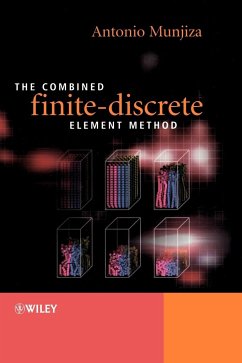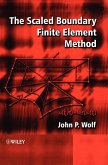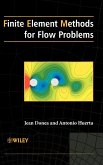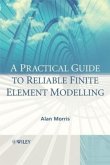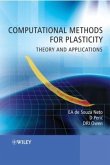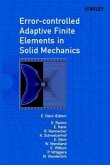Antonio A Munjiza
The Combined Finite-Discrete Element Method
Antonio A Munjiza
The Combined Finite-Discrete Element Method
- Gebundenes Buch
- Merkliste
- Auf die Merkliste
- Bewerten Bewerten
- Teilen
- Produkt teilen
- Produkterinnerung
- Produkterinnerung
The combined finite discrete element method is a relatively new computational tool aimed at problems involving static and / or dynamic behaviour of systems involving a large number of solid deformable bodies. Such problems include fragmentation using explosives (e.g rock blasting), impacts, demolition (collapsing buildings), blast loads, digging and loading processes, and powder technology. The combined finite-discrete element method - a natural extension of both discrete and finite element methods - allows researchers to model problems involving the deformability of either one solid body, a…mehr
Andere Kunden interessierten sich auch für
![The Scaled Boundary Finite Element Method The Scaled Boundary Finite Element Method]() John P. WolfThe Scaled Boundary Finite Element Method197,99 €
John P. WolfThe Scaled Boundary Finite Element Method197,99 €![Finite Element Methods for Flow Problems Finite Element Methods for Flow Problems]() Jean DoneaFinite Element Methods for Flow Problems215,99 €
Jean DoneaFinite Element Methods for Flow Problems215,99 €![A Practical Guide to Reliable Finite Element Modelling A Practical Guide to Reliable Finite Element Modelling]() Alan MorrisA Practical Guide to Reliable Finite Element Modelling174,99 €
Alan MorrisA Practical Guide to Reliable Finite Element Modelling174,99 €![Computational Methods for Plasticity Computational Methods for Plasticity]() E. A. de Souza NetoComputational Methods for Plasticity236,99 €
E. A. de Souza NetoComputational Methods for Plasticity236,99 €![Error-Controlled Adaptive Finite Elements in Solid Mechanics Error-Controlled Adaptive Finite Elements in Solid Mechanics]() Ekkehard RammError-Controlled Adaptive Finite Elements in Solid Mechanics285,99 €
Ekkehard RammError-Controlled Adaptive Finite Elements in Solid Mechanics285,99 €![Hydrodynamics of Free Surface Flows Hydrodynamics of Free Surface Flows]() Jean-Michel HervouetHydrodynamics of Free Surface Flows148,99 €
Jean-Michel HervouetHydrodynamics of Free Surface Flows148,99 €![Complex-Valued Neural Networks Complex-Valued Neural Networks]() Akira HiroseComplex-Valued Neural Networks109,99 €
Akira HiroseComplex-Valued Neural Networks109,99 €-
-
-
The combined finite discrete element method is a relatively new computational tool aimed at problems involving static and / or dynamic behaviour of systems involving a large number of solid deformable bodies. Such problems include fragmentation using explosives (e.g rock blasting), impacts, demolition (collapsing buildings), blast loads, digging and loading processes, and powder technology.
The combined finite-discrete element method - a natural extension of both discrete and finite element methods - allows researchers to model problems involving the deformability of either one solid body, a large number of bodies, or a solid body which fragments (e.g. in rock blasting applications a more or less intact rock mass is transformed into a pile of solid rock fragments of different sizes, which interact with each other). The topic is gaining in importance, and is at the forefront of some of the current efforts in computational modeling of the failure of solids.
_ Accompanying source codes plus input and output files available on the Internet
_ Important applications such as mining engineering, rock blasting and petroleum engineering
_ Includes practical examples of applications areas
Essential reading for postgraduates, researchers and software engineers working in mechanical engineering.
Hinweis: Dieser Artikel kann nur an eine deutsche Lieferadresse ausgeliefert werden.
The combined finite-discrete element method - a natural extension of both discrete and finite element methods - allows researchers to model problems involving the deformability of either one solid body, a large number of bodies, or a solid body which fragments (e.g. in rock blasting applications a more or less intact rock mass is transformed into a pile of solid rock fragments of different sizes, which interact with each other). The topic is gaining in importance, and is at the forefront of some of the current efforts in computational modeling of the failure of solids.
_ Accompanying source codes plus input and output files available on the Internet
_ Important applications such as mining engineering, rock blasting and petroleum engineering
_ Includes practical examples of applications areas
Essential reading for postgraduates, researchers and software engineers working in mechanical engineering.
Hinweis: Dieser Artikel kann nur an eine deutsche Lieferadresse ausgeliefert werden.
Produktdetails
- Produktdetails
- Verlag: Wiley & Sons
- 1. Auflage
- Seitenzahl: 352
- Erscheinungstermin: 2. April 2004
- Englisch
- Abmessung: 260mm x 183mm x 23mm
- Gewicht: 805g
- ISBN-13: 9780470841990
- ISBN-10: 0470841990
- Artikelnr.: 10944024
- Herstellerkennzeichnung
- Libri GmbH
- Europaallee 1
- 36244 Bad Hersfeld
- gpsr@libri.de
- Verlag: Wiley & Sons
- 1. Auflage
- Seitenzahl: 352
- Erscheinungstermin: 2. April 2004
- Englisch
- Abmessung: 260mm x 183mm x 23mm
- Gewicht: 805g
- ISBN-13: 9780470841990
- ISBN-10: 0470841990
- Artikelnr.: 10944024
- Herstellerkennzeichnung
- Libri GmbH
- Europaallee 1
- 36244 Bad Hersfeld
- gpsr@libri.de
Antonio A. Munjiza is the author of The Combined Finite-Discrete Element Method, published by Wiley.
Preface.
Acknowledgements.
1 Introduction.
1.1 General Formulation of Continuum Problems.
1.2 General Formulation of Discontinuum Problems.
1.3 A Typical Problem of Computational Mechanics of Discontinua.
1.4 Combined Continua-Discontinua Problems.
1.5 Transition from Continua to Discontinua.
1.6 The Combined Finite-Discrete Element Method.
1.7 Algorithmic and Computational Challenge of the Combined Finite-Discrete
Element Method.
2 Processing of Contact Interaction in the Combined Finite Discrete Element
Method.
2.1 Introduction.
2.2 The Penalty Function Method.
2.3 Potential Contact Force in 2D.
2.4 Discretisation of Contact Force in 2D.
2.5 Implementation Details for Discretised Contact Force in 2D.
2.6 Potential Contact Force in 3D.
2.6.1 Evaluation of contact force.
2.6.2 Computational aspects.
2.6.3 Physical interpretation of the penalty parameter.
2.6.4 Contact damping.
2.7 Alternative Implementation of the Potential Contact Force.
3 Contact Detection.
3.1 Introduction.
3.2 Direct Checking Contact Detection Algorithm.
3.2.1 Circular bounding box.
3.2.2 Square bounding object.
3.2.3 Complex bounding box.
3.3 Formulation of Contact Detection Problem for Bodies of Similar Size in
2D.
3.4 Binary Tree Based Contact Detection Algorithm for Discrete Elements of
Similar Size.
3.5 Direct Mapping Algorithm for Discrete Elements of Similar Size.
3.6 Screening Contact Detection Algorithm for Discrete Elements of Similar
Size.
3.7 Sorting Contact Detection Algorithm for Discrete Elements of a Similar
Size.
3.8 Munjiza-NBS Contact Detection Algorithm in 2D.
3.8.1 Space decomposition.
3.8.2 Mapping of discrete elements onto cells.
3.8.3 Mapping of discrete elements onto rows and columns of cells.
3.8.4 Representation of mapping.
3.9 Selection of Contact Detection Algorithm.
3.10 Generalisation of Contact Detection Algorithms to 3D Space.
3.10.1 Direct checking contact detection algorithm.
3.10.2 Binary tree search.
3.10.3 Screening contact detection algorithm.
3.10.4 Direct mapping contact detection algorithm.
3.11 Generalisation of Munjiza-NBS Contact Detection Algorithm to
Multidimensional Space.
3.12 Shape and Size Generalisation-Williams C-GRID Algorithm.
4 Deformability of Discrete Elements.
4.1 Deformation.
4.2 Deformation Gradient.
4.2.1 Frames of reference.
4.2.2 Transformation matrices.
4.3 Homogeneous Deformation.
4.4 Strain.
4.5 Stress.
4.5.1 Cauchy stress tensor.
4.5.2 First Piola-Kirchhoff stress tensor.
4.5.3 Second Piola-Kirchhoff stress tensor.
4.6 Constitutive Law.
4.7 Constant Strain Triangle Finite Element.
4.8 Constant Strain Tetrahedron Finite Element.
4.9 Numerical Demonstration of Finite Rotation Elasticity in the Combined
Finite-Discrete Element Method.
5 Temporal Discretisation.
5.1 The Central Difference Time Integration Scheme.
5.1.1 Stability of the central difference time integration scheme.
5.2 Dynamics of Irregular Discrete Elements Subject to Finite Rotations in
3D.
5.2.1 Frames of reference.
5.2.2 Kinematics of the discrete element in general motion.
5.2.3 Spatial orientation of the discrete element.
5.2.4 Transformation matrices.
5.2.5 The inertia of the discrete element.
5.2.6 Governing equation of motion.
5.2.7 Change in spatial orientation during a single time step.
5.6.8 Change in angular momentum due to external loads.
5.6.9 Change in angular velocity during a single time step.
5.6.10 Munjiza direct time integration scheme.
5.3 Alternative Explicit Time Integration Schemes.
5.3.1 The Central Difference time integration scheme (CD).
5.3.2 Gear's predictor-corrector time integration schemes (PC-3, PC-4, and
PC-5).
5.3.3 CHIN integration scheme.
5.3.4 OMF30 time integration scheme.
5.3.5 OMF32 time integration scheme.
5.3.6 Forest & Ruth time integration scheme.
5.4 The Combined Finite-Discrete Element Simulation of the State of Rest.
6 Sensitivity to Initial Conditions in Combined Finite-Discrete Element
Simulations.
6.1 Introduction.
6.2 Combined Finite-Discrete Element Systems.
7 Transition from Continua to Discontinua.
7.1 Introduction.
7.2 Strain Softening Based Smeared Fracture Model.
7.3 Discrete Crack Model.
7.4 A Need for More Robust Fracture Solutions.
8 Fluid Coupling in the Combined Finite-Discrete Element Method.
8.1 Introduction.
8.1.1 CFD with solid coupling.
8.1.2 Combined finite-discrete element method with CFD coupling.
8.2 Expansion of the Detonation Gas.
8.2.1 Equation of state.
8.2.2 Rigid chamber.
8.2.3 Isentropic adiabatic expansion of detonation gas.
8.2.4 Detonation gas expansion in a partially filled non-rigid chamber.
8.3 Gas Flow Through Fracturing Solid.
8.3.1 Constant area duct.
8.4 Coupled Combined Finite-Discrete Element Simulation of Explosive
Induced Fracture and Fragmentation.
8.4.1 Scaling of coupled combined finite-discrete element problems.
8.5 Other Applications.
9 Computational Aspects of Combined Finite-Discrete Element Simulations.
9.1 Large Scale Combined Finite-Discrete Element Simulations.
9.1.1 Minimising RAM requirements.
9.1.2 Minimising CPU requirements.
9.1.3 Minimising storage requirements.
9.1.4 Minimising risk.
9.1.5 Maximising transparency.
9.2 Very Large Scale Combined Finite-Discrete Element Simulations.
9.3 Grand Challenge Combined Finite-Discrete Element Simulations.
9.4 Why the C Programming Language?
9.5 Alternative Hardware Architectures.
9.5.1 Parallel computing.
9.5.2 Distributed computing.
9.5.3 Grid computing.
10 Implementation of some of the Core Combined Finite-Discrete Element
Algorithms.
10.1 Portability, Speed, Transparency and Reusability.
10.1.1 Use of new data types.
10.1.2 Use of MACROS.
10.2 Dynamic Memory Allocation.
10.3 Data Compression.
10.4 Potential Contact Force in 3D.
10.4.1 Interaction between two tetrahedrons.
10.5 Sorting Contact Detection Algorithm.
10.6 NBS Contact Detection Algorithm in 3D.
10.7 Deformability with Finite Rotations in 3D.
Bibliography.
Index.
Acknowledgements.
1 Introduction.
1.1 General Formulation of Continuum Problems.
1.2 General Formulation of Discontinuum Problems.
1.3 A Typical Problem of Computational Mechanics of Discontinua.
1.4 Combined Continua-Discontinua Problems.
1.5 Transition from Continua to Discontinua.
1.6 The Combined Finite-Discrete Element Method.
1.7 Algorithmic and Computational Challenge of the Combined Finite-Discrete
Element Method.
2 Processing of Contact Interaction in the Combined Finite Discrete Element
Method.
2.1 Introduction.
2.2 The Penalty Function Method.
2.3 Potential Contact Force in 2D.
2.4 Discretisation of Contact Force in 2D.
2.5 Implementation Details for Discretised Contact Force in 2D.
2.6 Potential Contact Force in 3D.
2.6.1 Evaluation of contact force.
2.6.2 Computational aspects.
2.6.3 Physical interpretation of the penalty parameter.
2.6.4 Contact damping.
2.7 Alternative Implementation of the Potential Contact Force.
3 Contact Detection.
3.1 Introduction.
3.2 Direct Checking Contact Detection Algorithm.
3.2.1 Circular bounding box.
3.2.2 Square bounding object.
3.2.3 Complex bounding box.
3.3 Formulation of Contact Detection Problem for Bodies of Similar Size in
2D.
3.4 Binary Tree Based Contact Detection Algorithm for Discrete Elements of
Similar Size.
3.5 Direct Mapping Algorithm for Discrete Elements of Similar Size.
3.6 Screening Contact Detection Algorithm for Discrete Elements of Similar
Size.
3.7 Sorting Contact Detection Algorithm for Discrete Elements of a Similar
Size.
3.8 Munjiza-NBS Contact Detection Algorithm in 2D.
3.8.1 Space decomposition.
3.8.2 Mapping of discrete elements onto cells.
3.8.3 Mapping of discrete elements onto rows and columns of cells.
3.8.4 Representation of mapping.
3.9 Selection of Contact Detection Algorithm.
3.10 Generalisation of Contact Detection Algorithms to 3D Space.
3.10.1 Direct checking contact detection algorithm.
3.10.2 Binary tree search.
3.10.3 Screening contact detection algorithm.
3.10.4 Direct mapping contact detection algorithm.
3.11 Generalisation of Munjiza-NBS Contact Detection Algorithm to
Multidimensional Space.
3.12 Shape and Size Generalisation-Williams C-GRID Algorithm.
4 Deformability of Discrete Elements.
4.1 Deformation.
4.2 Deformation Gradient.
4.2.1 Frames of reference.
4.2.2 Transformation matrices.
4.3 Homogeneous Deformation.
4.4 Strain.
4.5 Stress.
4.5.1 Cauchy stress tensor.
4.5.2 First Piola-Kirchhoff stress tensor.
4.5.3 Second Piola-Kirchhoff stress tensor.
4.6 Constitutive Law.
4.7 Constant Strain Triangle Finite Element.
4.8 Constant Strain Tetrahedron Finite Element.
4.9 Numerical Demonstration of Finite Rotation Elasticity in the Combined
Finite-Discrete Element Method.
5 Temporal Discretisation.
5.1 The Central Difference Time Integration Scheme.
5.1.1 Stability of the central difference time integration scheme.
5.2 Dynamics of Irregular Discrete Elements Subject to Finite Rotations in
3D.
5.2.1 Frames of reference.
5.2.2 Kinematics of the discrete element in general motion.
5.2.3 Spatial orientation of the discrete element.
5.2.4 Transformation matrices.
5.2.5 The inertia of the discrete element.
5.2.6 Governing equation of motion.
5.2.7 Change in spatial orientation during a single time step.
5.6.8 Change in angular momentum due to external loads.
5.6.9 Change in angular velocity during a single time step.
5.6.10 Munjiza direct time integration scheme.
5.3 Alternative Explicit Time Integration Schemes.
5.3.1 The Central Difference time integration scheme (CD).
5.3.2 Gear's predictor-corrector time integration schemes (PC-3, PC-4, and
PC-5).
5.3.3 CHIN integration scheme.
5.3.4 OMF30 time integration scheme.
5.3.5 OMF32 time integration scheme.
5.3.6 Forest & Ruth time integration scheme.
5.4 The Combined Finite-Discrete Element Simulation of the State of Rest.
6 Sensitivity to Initial Conditions in Combined Finite-Discrete Element
Simulations.
6.1 Introduction.
6.2 Combined Finite-Discrete Element Systems.
7 Transition from Continua to Discontinua.
7.1 Introduction.
7.2 Strain Softening Based Smeared Fracture Model.
7.3 Discrete Crack Model.
7.4 A Need for More Robust Fracture Solutions.
8 Fluid Coupling in the Combined Finite-Discrete Element Method.
8.1 Introduction.
8.1.1 CFD with solid coupling.
8.1.2 Combined finite-discrete element method with CFD coupling.
8.2 Expansion of the Detonation Gas.
8.2.1 Equation of state.
8.2.2 Rigid chamber.
8.2.3 Isentropic adiabatic expansion of detonation gas.
8.2.4 Detonation gas expansion in a partially filled non-rigid chamber.
8.3 Gas Flow Through Fracturing Solid.
8.3.1 Constant area duct.
8.4 Coupled Combined Finite-Discrete Element Simulation of Explosive
Induced Fracture and Fragmentation.
8.4.1 Scaling of coupled combined finite-discrete element problems.
8.5 Other Applications.
9 Computational Aspects of Combined Finite-Discrete Element Simulations.
9.1 Large Scale Combined Finite-Discrete Element Simulations.
9.1.1 Minimising RAM requirements.
9.1.2 Minimising CPU requirements.
9.1.3 Minimising storage requirements.
9.1.4 Minimising risk.
9.1.5 Maximising transparency.
9.2 Very Large Scale Combined Finite-Discrete Element Simulations.
9.3 Grand Challenge Combined Finite-Discrete Element Simulations.
9.4 Why the C Programming Language?
9.5 Alternative Hardware Architectures.
9.5.1 Parallel computing.
9.5.2 Distributed computing.
9.5.3 Grid computing.
10 Implementation of some of the Core Combined Finite-Discrete Element
Algorithms.
10.1 Portability, Speed, Transparency and Reusability.
10.1.1 Use of new data types.
10.1.2 Use of MACROS.
10.2 Dynamic Memory Allocation.
10.3 Data Compression.
10.4 Potential Contact Force in 3D.
10.4.1 Interaction between two tetrahedrons.
10.5 Sorting Contact Detection Algorithm.
10.6 NBS Contact Detection Algorithm in 3D.
10.7 Deformability with Finite Rotations in 3D.
Bibliography.
Index.
Preface.
Acknowledgements.
1 Introduction.
1.1 General Formulation of Continuum Problems.
1.2 General Formulation of Discontinuum Problems.
1.3 A Typical Problem of Computational Mechanics of Discontinua.
1.4 Combined Continua-Discontinua Problems.
1.5 Transition from Continua to Discontinua.
1.6 The Combined Finite-Discrete Element Method.
1.7 Algorithmic and Computational Challenge of the Combined Finite-Discrete
Element Method.
2 Processing of Contact Interaction in the Combined Finite Discrete Element
Method.
2.1 Introduction.
2.2 The Penalty Function Method.
2.3 Potential Contact Force in 2D.
2.4 Discretisation of Contact Force in 2D.
2.5 Implementation Details for Discretised Contact Force in 2D.
2.6 Potential Contact Force in 3D.
2.6.1 Evaluation of contact force.
2.6.2 Computational aspects.
2.6.3 Physical interpretation of the penalty parameter.
2.6.4 Contact damping.
2.7 Alternative Implementation of the Potential Contact Force.
3 Contact Detection.
3.1 Introduction.
3.2 Direct Checking Contact Detection Algorithm.
3.2.1 Circular bounding box.
3.2.2 Square bounding object.
3.2.3 Complex bounding box.
3.3 Formulation of Contact Detection Problem for Bodies of Similar Size in
2D.
3.4 Binary Tree Based Contact Detection Algorithm for Discrete Elements of
Similar Size.
3.5 Direct Mapping Algorithm for Discrete Elements of Similar Size.
3.6 Screening Contact Detection Algorithm for Discrete Elements of Similar
Size.
3.7 Sorting Contact Detection Algorithm for Discrete Elements of a Similar
Size.
3.8 Munjiza-NBS Contact Detection Algorithm in 2D.
3.8.1 Space decomposition.
3.8.2 Mapping of discrete elements onto cells.
3.8.3 Mapping of discrete elements onto rows and columns of cells.
3.8.4 Representation of mapping.
3.9 Selection of Contact Detection Algorithm.
3.10 Generalisation of Contact Detection Algorithms to 3D Space.
3.10.1 Direct checking contact detection algorithm.
3.10.2 Binary tree search.
3.10.3 Screening contact detection algorithm.
3.10.4 Direct mapping contact detection algorithm.
3.11 Generalisation of Munjiza-NBS Contact Detection Algorithm to
Multidimensional Space.
3.12 Shape and Size Generalisation-Williams C-GRID Algorithm.
4 Deformability of Discrete Elements.
4.1 Deformation.
4.2 Deformation Gradient.
4.2.1 Frames of reference.
4.2.2 Transformation matrices.
4.3 Homogeneous Deformation.
4.4 Strain.
4.5 Stress.
4.5.1 Cauchy stress tensor.
4.5.2 First Piola-Kirchhoff stress tensor.
4.5.3 Second Piola-Kirchhoff stress tensor.
4.6 Constitutive Law.
4.7 Constant Strain Triangle Finite Element.
4.8 Constant Strain Tetrahedron Finite Element.
4.9 Numerical Demonstration of Finite Rotation Elasticity in the Combined
Finite-Discrete Element Method.
5 Temporal Discretisation.
5.1 The Central Difference Time Integration Scheme.
5.1.1 Stability of the central difference time integration scheme.
5.2 Dynamics of Irregular Discrete Elements Subject to Finite Rotations in
3D.
5.2.1 Frames of reference.
5.2.2 Kinematics of the discrete element in general motion.
5.2.3 Spatial orientation of the discrete element.
5.2.4 Transformation matrices.
5.2.5 The inertia of the discrete element.
5.2.6 Governing equation of motion.
5.2.7 Change in spatial orientation during a single time step.
5.6.8 Change in angular momentum due to external loads.
5.6.9 Change in angular velocity during a single time step.
5.6.10 Munjiza direct time integration scheme.
5.3 Alternative Explicit Time Integration Schemes.
5.3.1 The Central Difference time integration scheme (CD).
5.3.2 Gear's predictor-corrector time integration schemes (PC-3, PC-4, and
PC-5).
5.3.3 CHIN integration scheme.
5.3.4 OMF30 time integration scheme.
5.3.5 OMF32 time integration scheme.
5.3.6 Forest & Ruth time integration scheme.
5.4 The Combined Finite-Discrete Element Simulation of the State of Rest.
6 Sensitivity to Initial Conditions in Combined Finite-Discrete Element
Simulations.
6.1 Introduction.
6.2 Combined Finite-Discrete Element Systems.
7 Transition from Continua to Discontinua.
7.1 Introduction.
7.2 Strain Softening Based Smeared Fracture Model.
7.3 Discrete Crack Model.
7.4 A Need for More Robust Fracture Solutions.
8 Fluid Coupling in the Combined Finite-Discrete Element Method.
8.1 Introduction.
8.1.1 CFD with solid coupling.
8.1.2 Combined finite-discrete element method with CFD coupling.
8.2 Expansion of the Detonation Gas.
8.2.1 Equation of state.
8.2.2 Rigid chamber.
8.2.3 Isentropic adiabatic expansion of detonation gas.
8.2.4 Detonation gas expansion in a partially filled non-rigid chamber.
8.3 Gas Flow Through Fracturing Solid.
8.3.1 Constant area duct.
8.4 Coupled Combined Finite-Discrete Element Simulation of Explosive
Induced Fracture and Fragmentation.
8.4.1 Scaling of coupled combined finite-discrete element problems.
8.5 Other Applications.
9 Computational Aspects of Combined Finite-Discrete Element Simulations.
9.1 Large Scale Combined Finite-Discrete Element Simulations.
9.1.1 Minimising RAM requirements.
9.1.2 Minimising CPU requirements.
9.1.3 Minimising storage requirements.
9.1.4 Minimising risk.
9.1.5 Maximising transparency.
9.2 Very Large Scale Combined Finite-Discrete Element Simulations.
9.3 Grand Challenge Combined Finite-Discrete Element Simulations.
9.4 Why the C Programming Language?
9.5 Alternative Hardware Architectures.
9.5.1 Parallel computing.
9.5.2 Distributed computing.
9.5.3 Grid computing.
10 Implementation of some of the Core Combined Finite-Discrete Element
Algorithms.
10.1 Portability, Speed, Transparency and Reusability.
10.1.1 Use of new data types.
10.1.2 Use of MACROS.
10.2 Dynamic Memory Allocation.
10.3 Data Compression.
10.4 Potential Contact Force in 3D.
10.4.1 Interaction between two tetrahedrons.
10.5 Sorting Contact Detection Algorithm.
10.6 NBS Contact Detection Algorithm in 3D.
10.7 Deformability with Finite Rotations in 3D.
Bibliography.
Index.
Acknowledgements.
1 Introduction.
1.1 General Formulation of Continuum Problems.
1.2 General Formulation of Discontinuum Problems.
1.3 A Typical Problem of Computational Mechanics of Discontinua.
1.4 Combined Continua-Discontinua Problems.
1.5 Transition from Continua to Discontinua.
1.6 The Combined Finite-Discrete Element Method.
1.7 Algorithmic and Computational Challenge of the Combined Finite-Discrete
Element Method.
2 Processing of Contact Interaction in the Combined Finite Discrete Element
Method.
2.1 Introduction.
2.2 The Penalty Function Method.
2.3 Potential Contact Force in 2D.
2.4 Discretisation of Contact Force in 2D.
2.5 Implementation Details for Discretised Contact Force in 2D.
2.6 Potential Contact Force in 3D.
2.6.1 Evaluation of contact force.
2.6.2 Computational aspects.
2.6.3 Physical interpretation of the penalty parameter.
2.6.4 Contact damping.
2.7 Alternative Implementation of the Potential Contact Force.
3 Contact Detection.
3.1 Introduction.
3.2 Direct Checking Contact Detection Algorithm.
3.2.1 Circular bounding box.
3.2.2 Square bounding object.
3.2.3 Complex bounding box.
3.3 Formulation of Contact Detection Problem for Bodies of Similar Size in
2D.
3.4 Binary Tree Based Contact Detection Algorithm for Discrete Elements of
Similar Size.
3.5 Direct Mapping Algorithm for Discrete Elements of Similar Size.
3.6 Screening Contact Detection Algorithm for Discrete Elements of Similar
Size.
3.7 Sorting Contact Detection Algorithm for Discrete Elements of a Similar
Size.
3.8 Munjiza-NBS Contact Detection Algorithm in 2D.
3.8.1 Space decomposition.
3.8.2 Mapping of discrete elements onto cells.
3.8.3 Mapping of discrete elements onto rows and columns of cells.
3.8.4 Representation of mapping.
3.9 Selection of Contact Detection Algorithm.
3.10 Generalisation of Contact Detection Algorithms to 3D Space.
3.10.1 Direct checking contact detection algorithm.
3.10.2 Binary tree search.
3.10.3 Screening contact detection algorithm.
3.10.4 Direct mapping contact detection algorithm.
3.11 Generalisation of Munjiza-NBS Contact Detection Algorithm to
Multidimensional Space.
3.12 Shape and Size Generalisation-Williams C-GRID Algorithm.
4 Deformability of Discrete Elements.
4.1 Deformation.
4.2 Deformation Gradient.
4.2.1 Frames of reference.
4.2.2 Transformation matrices.
4.3 Homogeneous Deformation.
4.4 Strain.
4.5 Stress.
4.5.1 Cauchy stress tensor.
4.5.2 First Piola-Kirchhoff stress tensor.
4.5.3 Second Piola-Kirchhoff stress tensor.
4.6 Constitutive Law.
4.7 Constant Strain Triangle Finite Element.
4.8 Constant Strain Tetrahedron Finite Element.
4.9 Numerical Demonstration of Finite Rotation Elasticity in the Combined
Finite-Discrete Element Method.
5 Temporal Discretisation.
5.1 The Central Difference Time Integration Scheme.
5.1.1 Stability of the central difference time integration scheme.
5.2 Dynamics of Irregular Discrete Elements Subject to Finite Rotations in
3D.
5.2.1 Frames of reference.
5.2.2 Kinematics of the discrete element in general motion.
5.2.3 Spatial orientation of the discrete element.
5.2.4 Transformation matrices.
5.2.5 The inertia of the discrete element.
5.2.6 Governing equation of motion.
5.2.7 Change in spatial orientation during a single time step.
5.6.8 Change in angular momentum due to external loads.
5.6.9 Change in angular velocity during a single time step.
5.6.10 Munjiza direct time integration scheme.
5.3 Alternative Explicit Time Integration Schemes.
5.3.1 The Central Difference time integration scheme (CD).
5.3.2 Gear's predictor-corrector time integration schemes (PC-3, PC-4, and
PC-5).
5.3.3 CHIN integration scheme.
5.3.4 OMF30 time integration scheme.
5.3.5 OMF32 time integration scheme.
5.3.6 Forest & Ruth time integration scheme.
5.4 The Combined Finite-Discrete Element Simulation of the State of Rest.
6 Sensitivity to Initial Conditions in Combined Finite-Discrete Element
Simulations.
6.1 Introduction.
6.2 Combined Finite-Discrete Element Systems.
7 Transition from Continua to Discontinua.
7.1 Introduction.
7.2 Strain Softening Based Smeared Fracture Model.
7.3 Discrete Crack Model.
7.4 A Need for More Robust Fracture Solutions.
8 Fluid Coupling in the Combined Finite-Discrete Element Method.
8.1 Introduction.
8.1.1 CFD with solid coupling.
8.1.2 Combined finite-discrete element method with CFD coupling.
8.2 Expansion of the Detonation Gas.
8.2.1 Equation of state.
8.2.2 Rigid chamber.
8.2.3 Isentropic adiabatic expansion of detonation gas.
8.2.4 Detonation gas expansion in a partially filled non-rigid chamber.
8.3 Gas Flow Through Fracturing Solid.
8.3.1 Constant area duct.
8.4 Coupled Combined Finite-Discrete Element Simulation of Explosive
Induced Fracture and Fragmentation.
8.4.1 Scaling of coupled combined finite-discrete element problems.
8.5 Other Applications.
9 Computational Aspects of Combined Finite-Discrete Element Simulations.
9.1 Large Scale Combined Finite-Discrete Element Simulations.
9.1.1 Minimising RAM requirements.
9.1.2 Minimising CPU requirements.
9.1.3 Minimising storage requirements.
9.1.4 Minimising risk.
9.1.5 Maximising transparency.
9.2 Very Large Scale Combined Finite-Discrete Element Simulations.
9.3 Grand Challenge Combined Finite-Discrete Element Simulations.
9.4 Why the C Programming Language?
9.5 Alternative Hardware Architectures.
9.5.1 Parallel computing.
9.5.2 Distributed computing.
9.5.3 Grid computing.
10 Implementation of some of the Core Combined Finite-Discrete Element
Algorithms.
10.1 Portability, Speed, Transparency and Reusability.
10.1.1 Use of new data types.
10.1.2 Use of MACROS.
10.2 Dynamic Memory Allocation.
10.3 Data Compression.
10.4 Potential Contact Force in 3D.
10.4.1 Interaction between two tetrahedrons.
10.5 Sorting Contact Detection Algorithm.
10.6 NBS Contact Detection Algorithm in 3D.
10.7 Deformability with Finite Rotations in 3D.
Bibliography.
Index.

